10 Best Python Books for Beginners and Advanced Programmers (2025)
By Wiingy on Jun 05, 2024
Updated Jul 17, 2025

In this article
 Best Python Books to Learn From
Best Python Books to Learn From For Absolute Beginners and Novices
For Absolute Beginners and Novices 1. Python Crash Course: A Hands-On, Project-Based Introduction To Programming by Eric Matthes
1. Python Crash Course: A Hands-On, Project-Based Introduction To Programming by Eric Matthes 2. “Automate the Boring Stuff with Python: Practical Programming for Total Beginners” by Al Sweigart
2. “Automate the Boring Stuff with Python: Practical Programming for Total Beginners” by Al Sweigart 3. “Learn Python 3 the Hard Way: A Very Simple Introduction to the Terrifyingly Beautiful World of Computers and Code” by Zed Shaw
3. “Learn Python 3 the Hard Way: A Very Simple Introduction to the Terrifyingly Beautiful World of Computers and Code” by Zed Shaw 4. “Head First Python: A Brain-Friendly Guide” – By Paul Barry
4. “Head First Python: A Brain-Friendly Guide” – By Paul Barry 5. “Python for Everybody: Exploring Data in Python 3” by Charles R. Severance
5. “Python for Everybody: Exploring Data in Python 3” by Charles R. Severance For Advanced Programmers
For Advanced Programmers 2.“Effective Python: 90 Specific Ways to Write Better Python” by Brett Slatkin
2.“Effective Python: 90 Specific Ways to Write Better Python” by Brett Slatkin Conclusion
Conclusion Additional Resources
Additional Resources
Python is one of the most popular programming languages in the world, known for its simplicity, versatility, and ease of use. It has various applications throughout the industry which we have discussed about in our blogs. To learn Python, check out our free Python Tutorial for beginners.
To supplement your reading, check out the best apps to learn Python for hands-on practice and better retention.
While books may seem like an unorthodox medium for studying coding in present times. This article has compiled a list of essential books that will help you learn Python whether you are a beginner or an advanced programmer.
Looking to Learn Python? Book a Free Trial Lesson and match with top Python Tutors for concepts, projects and assignment help on Wiingy today!
Best Python Books to Learn From
For beginners, the following five books are great resources for learning Python from the ground up:
- “Python Crash Course: A Hands-On, Project-Based Introduction to Programming” by Eric Matthes”
- Automate the Boring Stuff with Python: Practical Programming for Total Beginners” by Al Sweigart”
- Learn Python the Hard Way: A Very Simple Introduction to the Terrifyingly Beautiful World of Computers and Code” by Zed A. Shaw”
- Python for Everybody: Exploring Data in Python 3″ by Charles Severance
- “Head First Python: A Brain-Friendly Guide” by Paul Barry
For advanced programmers, the following five books are great resources for mastering Python by learning more advanced techniques:
- “Fluent Python: Clear, Concise, and Effective Programming” by Luciano Ramalho
- “Python Cookbook: Recipes for Mastering Python 3″ by David Beazley and Brian K. Jones
- “Effective Python: 90 Specific Ways to Write Better Python” by Brett Slatkin
- “Python for Data Analysis: Data Wrangling with Pandas, NumPy, and IPython” by Wes McKinney
- “High-Performance Python: Practical Performant Programming” by Micha Gorelick and Ian Ozsvald
For Absolute Beginners and Novices
1. Python Crash Course: A Hands-On, Project-Based Introduction To Programming by Eric Matthes
| Book Title | Author | Expertise | Level of Difficulty | Ratings and Reviews | Pricing |
|---|---|---|---|---|---|
| Python Crash Course | Eric Matthes | Experienced Python Developer | Beginner | 4.7/5 on Amazon | $30.76 |
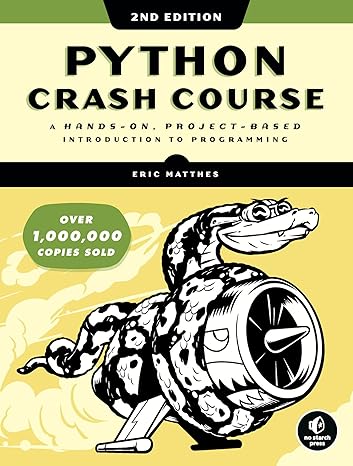
Python Crash Course is an introductory book that offers a quick overview of the Python Programming language. It provides detailed explanations of fundamental concepts to help beginners write real programs and apply them to complex 2D games and applications efficiently.
In the beginning, you’ll learn fundamental programming concepts, including variables, lists, classes, and loops. You’ll get to practice writing clean code through exercises for each topic. Additionally, you’ll learn how to make your programs interactive and test your code safely before integrating it into a project.
Finally, you’ll apply your newfound knowledge by creating a Space Invaders-style arcade game, constructing a set of data visualizations using Python’s convenient libraries, and deploying a basic application online.
The third edition of this book incorporates all the latest Python 3 code and includes VS Code for text editing, the pathlib module for file-handling, pytest for testing your code, as well as the latest features of Matplotlib, Plotly, and Django.
2. “Automate the Boring Stuff with Python: Practical Programming for Total Beginners” by Al Sweigart
| Book Title | Author | Expertise | Level of Difficulty | Ratings and Reviews | Pricing |
|---|---|---|---|---|---|
| Automate the Boring Stuff with Python | Al Sweigart | Experienced Python Developer | Beginner | 4.7/5 on Amazon | $33.76 |
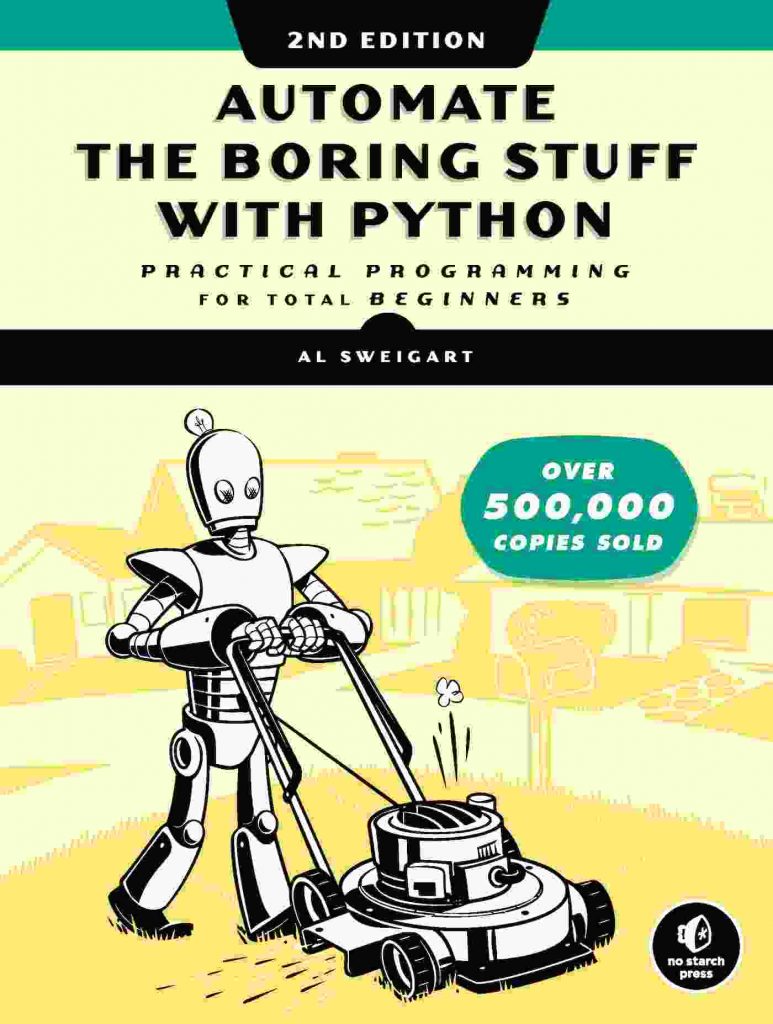
Automate the Boring Stuff with Python, 2nd Edition is a highly regarded book that teaches even those who are not technically inclined how to write programs that can perform tasks in minutes instead of hours. The book takes a practical approach to introducing Python programming to beginners, which makes it enjoyable and engaging.
The author, AI Sweigart, challenges readers with new practice tasks at the end of each chapter. Readers will learn the fundamentals of Python and explore a variety of library modules for tasks such as reading PDF and word documents, streamlining processes with clicks and keystrokes, and extracting data from websites.
The latest edition of the book features a new chapter on input validation, instructions for automating Gmail and Google Sheets, guidance on updating existing CSV files, and more.
This new chapter covers how to create programs that automate tasks such as searching for messages in files or across multiple files, creating, updating, moving, and renaming files and folders, searching the web, downloading online content, modifying and formatting data in Excel spreadsheets of any size, filling out online forms, and more.
3. “Learn Python 3 the Hard Way: A Very Simple Introduction to the Terrifyingly Beautiful World of Computers and Code” by Zed Shaw
| Book Title | Author | Expertise | Level of Difficulty | Ratings and Reviews | Pricing |
|---|---|---|---|---|---|
| Learn Python 3 The Hard Way | Zed Shaw | Software Developer | Beginner | 4.4/5 on Amazon | $27.99 |
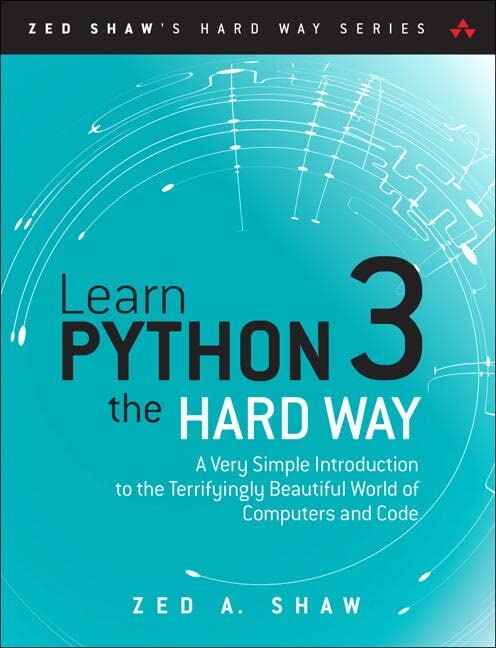
As the title suggests, the book takes a “hard way” approach to learning, which means that you’ll be actively practicing and solving problems instead of just reading and memorizing concepts. This approach is great for building your confidence and understanding of the language, and hence considered one of the best python books to learn from.
The book also covers fundamental programming concepts like exception handling and development tools. The book also covers Python tools for more advanced readers and programmers, such as decorators, descriptors, metaclasses, and Unicode processing.
This book instructs you in Python by slowly building and establishing skills through techniques such as practice and memorization, and then applying them to increasingly difficult problems. By the end of the book you will have the tools needed to begin learning more complex programming topics. Zed likes to tell people that the book gives you your “programming black belt” and hence widely recommended across the programming community.
4. “Head First Python: A Brain-Friendly Guide” – By Paul Barry
| Book Title | Author | Expertise | Level of Difficulty | Ratings and Reviews | Pricing |
|---|---|---|---|---|---|
| Head First Python: A Brain-Friendly Guide | Paul Barry | Experienced Python Developer | Beginner | 4.6/5 on Amazon | $49.77 |
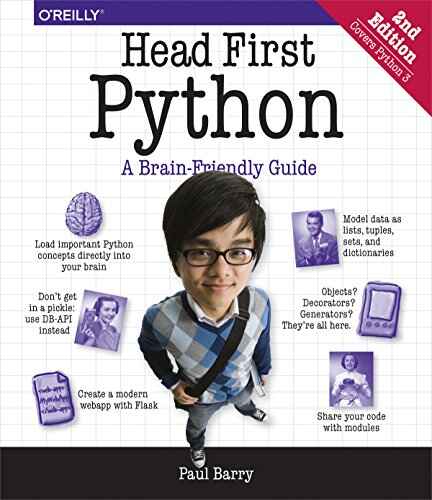
This book by Paul Barry is another good place to start learning Python for beginners. It is a quick and easy solution for students who want to learn the fundamentals of Python programming without having to slog through ineffective tutorials and books. This book simplifies working with built-in functions and data structures as well as learning the fundamentals of Python programming.
The book then moves on to topics such as data manipulation, exception management, and creating your own web application.
Paul Barry is a lecturer at Carlow Institute of Technology in Ireland. He has several other publications and has worked in the IT industry for over a decade.
It takes a unique approach to teaching Python, using visuals and diagrams to help beginners learn the language. The book covers everything from basic syntax to advanced topics like web development and data analysis, with a focus on practical examples and real-world applications. The book is written in a conversational style and is designed to be easy to read and understand.
5. “Python for Everybody: Exploring Data in Python 3” by Charles R. Severance
| Book Title | Author | Expertise | Level of Difficulty | Ratings and Reviews | Pricing |
|---|---|---|---|---|---|
| Python for Everybody: Exploring Data in Python 3 | Charles R. Severance | Experienced Python Developer | Beginner | 4.6/5 on Amazon | $9.99 |
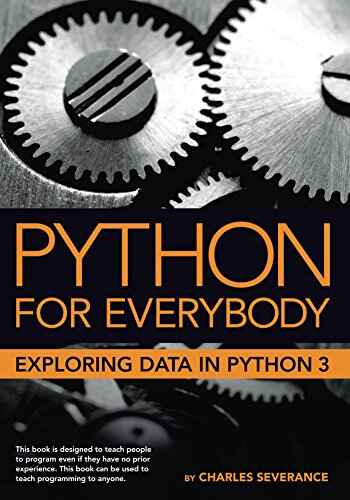
Python for Everybody by Charles is an excellent resource for anyone looking to learn the Python programming language. It’s written in a way that’s easy to understand and makes learning the language feel approachable even for beginners.
One of the things that makes Python for Everybody stand out is its focus on real-world applications. The author provides plenty of examples and exercises that help readers apply what they’ve learned to practical problems. This approach helps readers see the relevance of programming to their lives and keeps them engaged throughout the learning process.
Additionally, the book includes plenty of online resources, including video lectures and practice exercises, which are all available for free on the author’s website. These resources are a great way to supplement the material in the book and reinforce what you’ve learned.
Overall, Python for Everybody is an excellent resource for anyone looking to learn Python. Whether you’re a complete beginner or have some programming experience, the book’s approachable writing style and practical focus make it an excellent choice for anyone who wants to learn how to code in Python.
For Advanced Programmers
1.“Fluent Python: Clear, Concise, and Effective Programming” by Luciano Ramalho
| Book Title | Author | Expertise | Level of Difficulty | Ratings and Reviews | Pricing |
|---|---|---|---|---|---|
| Fluent Python: Clear, Concise, and Effective Programming | Luciano Ramalho | Experienced Python Developer | Advanced | 4.7/5 on Amazon | $50.99 |
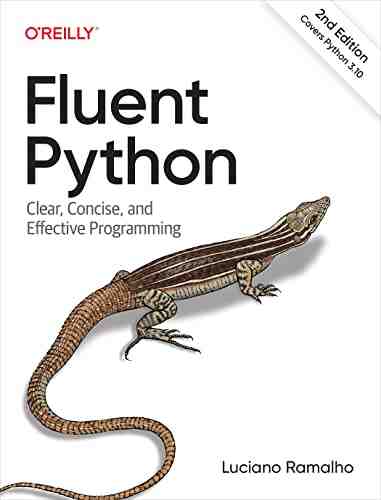
This book was written for practicing Python programmers who want to become proficient in Python 3. The new edition features five sub-categories and updates for Python 3.10 throughout the book, including :
- Data structures: Sequences, dicts, sets, Unicode, and data classes
- Functions as objects: First-class functions, related design patterns, and type hints in function declarations
- Object-oriented idioms: Composition, inheritance, mixins, interfaces, operator overloading, protocols, and more static types
- Control flow: Context managers, generators, coroutines, async/await, and thread/process pools
- Metaprogramming: Properties, attribute descriptors, class decorators, and new class metaprogramming hooks that replace or simplify metaclasses
Additionally, this book also works well as a reference/guide for an experienced programmer from another language who wants to look up “How do I do <xyz> in Python?” It provides more detailed explanations and code snippets than ones you’d find on StackOverflow.
2.“Effective Python: 90 Specific Ways to Write Better Python” by Brett Slatkin
| Book Title | Author | Expertise | Level of Difficulty | Ratings and Reviews | Pricing |
|---|---|---|---|---|---|
| Effective Python: 90 Specific Ways to Write Better Python | Brett Slatkin | Experienced Python Developer | Advanced | 4.7/5 on Amazon | $40.86 |
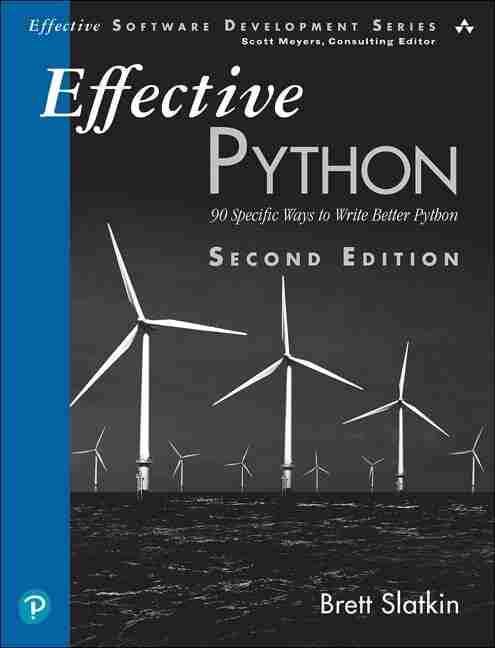
The author, Brett Slatkin, is an experienced Python developer who has distilled his knowledge and expertise into this book. He has divided this book into 90 short and focused sections, each of which provide clear methods to use python more effectively and to avoid commonly faced pitfalls.
This second edition of Effective Python will help you master a truly “Pythonic” approach to programming, harnessing Python’s full power to write exceptionally robust and well-performing code. Drawing on years of experience building Python infrastructure at Google, Slatkin uncovers little-known quirks and idioms that powerfully impact code behavior and performance. You’ll understand the best way to accomplish key tasks so you can write code that’s easier to understand, maintain, and improve
The revised edition uses more efficient solutions for the concepts and helps the reader make the most out of the modern python updates.
3. “High Performance Python: Practical Performant Programming” by Micha Gorelick and Ian Ozsvald
| Book Title | Author | Expertise | Level of Difficulty | Ratings and Reviews | Pricing |
|---|---|---|---|---|---|
| High Performance Python : Practical Performant Programming | Micha Gorelick Ian Ozsvald | Experienced Python Developer | Advanced | 4.7/5 on Amazon | $32.99 |
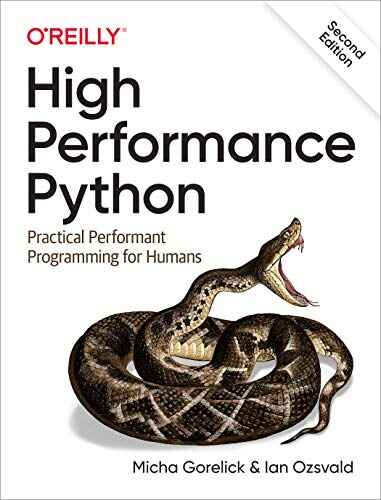
This book is meant for intermediate to advanced Python programmers. Motivated novice Python programmers may be able to follow along as well, but it’s recommended to have a solid Python foundation. It has been revised and updated for Python 3.
While this book is primarily aimed at people with CPU-bound problems, it also looks at data transfer and memory-bound solutions. Typically, these problems are faced by scientists, engineers, quants, and academics.
It also looks at problems that a web developer might face, including the movement of data and the use of just-in-time (JIT) compilers like PyPy and asynchronous I/O for easy-win performance gains.
Experienced Python programmers will learn concrete solutions to many issues, along with war stories from companies that use high-performance Python for social media analytics, productionized machine learning, and more.
4. “Python Cookbook: Recipes for Mastering Python 3” by David Beazley and Brian K. Jones
| Book Title | Author | Expertise | Level of Difficulty | Ratings and Reviews | Pricing |
|---|---|---|---|---|---|
| Python Cookbook: Recipes for Mastering Python 3 | David Beazley Brian K. Jones | Experienced Python Developer | Advanced | 4.6/5 on Amazon | $51.48 |
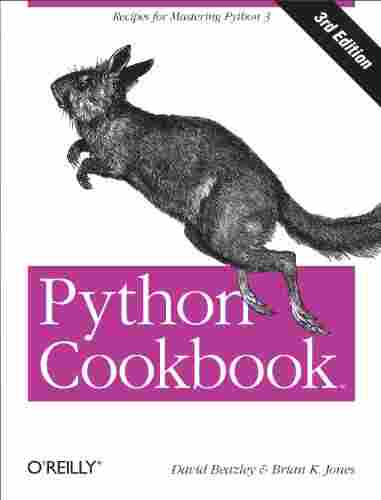
The “Python Cookbook” teaches the reader how to master Python 3 programming as well as how to update Python 2 code. This cookbook is chock-full of Python 3-tested recipes. The third edition is recommended for experienced Python programmers who prefer to use modern tools and idioms over basic coding.
It is a collection of practical tips and tricks for writing efficient and effective Python code. The book covers topics like file I/O, string manipulation, and data structures, and includes code samples and real-world examples to help you apply what you’ve learned.
Many of the more advanced recipes will reward the reader’s patience with a much greater insight into how Python actually works under the covers. You will learn new tricks and techniques that can be applied to your own code.
5. “Python for Data Analysis: Data Wrangling with Pandas, NumPy, and IPython” by Wes McKinney
| Book Title | Author | Expertise | Level of Difficulty | Ratings and Reviews | Pricing |
|---|---|---|---|---|---|
| Python for Data Analysis: Data Wrangling with Pandas, NumPy, and IPython | Wes McKinney | Experienced Python Developer | Advanced | 4.4/5 on Amazon | $36.18 |

This book is an excellent resource for anyone who wants to work with data using Python. The book covers the essential tools and libraries for data wrangling, including Pandas, NumPy, and IPython. The book also includes practical examples and real-world applications, making it easy to understand and apply what you’ve learned. The revised edition is updated for Python 3.10 and helps the reader learn data science tools like :
- Use the Jupyter Notebook and IPython shell for exploratory computing
- Learn basic and advanced features in NumPy
- Use flexible tools to load, clean, transform, merge, and reshape data
- Get started with data analysis tools in the pandas library
- Create informative visualizations with matplotlib
- Apply the pandas group facility to slice, dice, and summarize datasets
- Analyze and manipulate regular and irregular time series data
- Learn how to solve real-world data analysis problems with thorough, detailed examples
Conclusion
Python is an excellent language for both beginners and advanced programmers, and there are many great resources available for learning and improving your Python skills. Whether you are interested in web development, data analysis, automation, or machine learning, Python will be a useful addition to help you grasp these concepts better.
While these books are great for mastering Python, complement them with the best YouTube channels to learn data science to expand your skills.
For additional help, Wiingy offers expert and personalized Python tutors who guarantee to help you master Python concepts faster.
By reading the books listed above and practicing your skills, you can become a proficient Python programmer and take your career to the next level. These books are handpicked to suit your specific needs. If you need additional help in learning Python, you can use our Python resources, opt for tutoring or check out our blog on Python courses.
How long does it take to learn Python?
It usually takes around 2-6 months varying on the time invested everyday. Python has a simple syntax and can be learnt easily with books, courses or a tutor. It is in high demand and hence it’s to learn it.
Is Head First Python a good book?
Yes, Head First is a book series that specializes in introductory content for major concepts. It has a conversational style with a non-standard design and layout which makes it a good read for beginners and novices.
Can I learn Python from a book?
Yes, the books listed in the article above will provide enough explanation and resources for a novice/beginner to learn python with ease. You just have to apply the things you learnt in a practical environment. Most of the books offer online resources that you can use for free.
Additional Resources
- How to Learn Python
- Companies Using Python
- Best Python Courses to Learn From
- Top Applications of Python

Jul 17, 2025
Was this helpful?





